2808NRS Concept Map: Analyzing Acute Kidney Injury Case Study
VerifiedAdded on 2021/10/01
|6
|1335
|86
Project
AI Summary
This project presents a concept map created by a student, analyzing a case study of a 74-year-old patient, Mr. Paul Smith, experiencing Acute Kidney Injury (AKI). The concept map details the aetiology of AKI, identifying risk factors such as heart failure and age-related changes. It explores the pathophysiology, including impaired kidney perfusion due to reduced renal blood flow, and the release of renin. The clinical manifestations like pitting oedema, heart palpitations, and decreased urine output are outlined, alongside diagnostic methods such as blood tests, ECG, and eGFR. The treatment section highlights the use of loop diuretics, ACE inhibitors, and monitoring fluid balance. The analysis draws on various medical references to support the understanding of AKI, emphasizing the importance of early diagnosis and management. The document provides a comprehensive overview of AKI, its causes, effects, and management strategies, making it a useful resource for nursing students or healthcare professionals studying this condition.
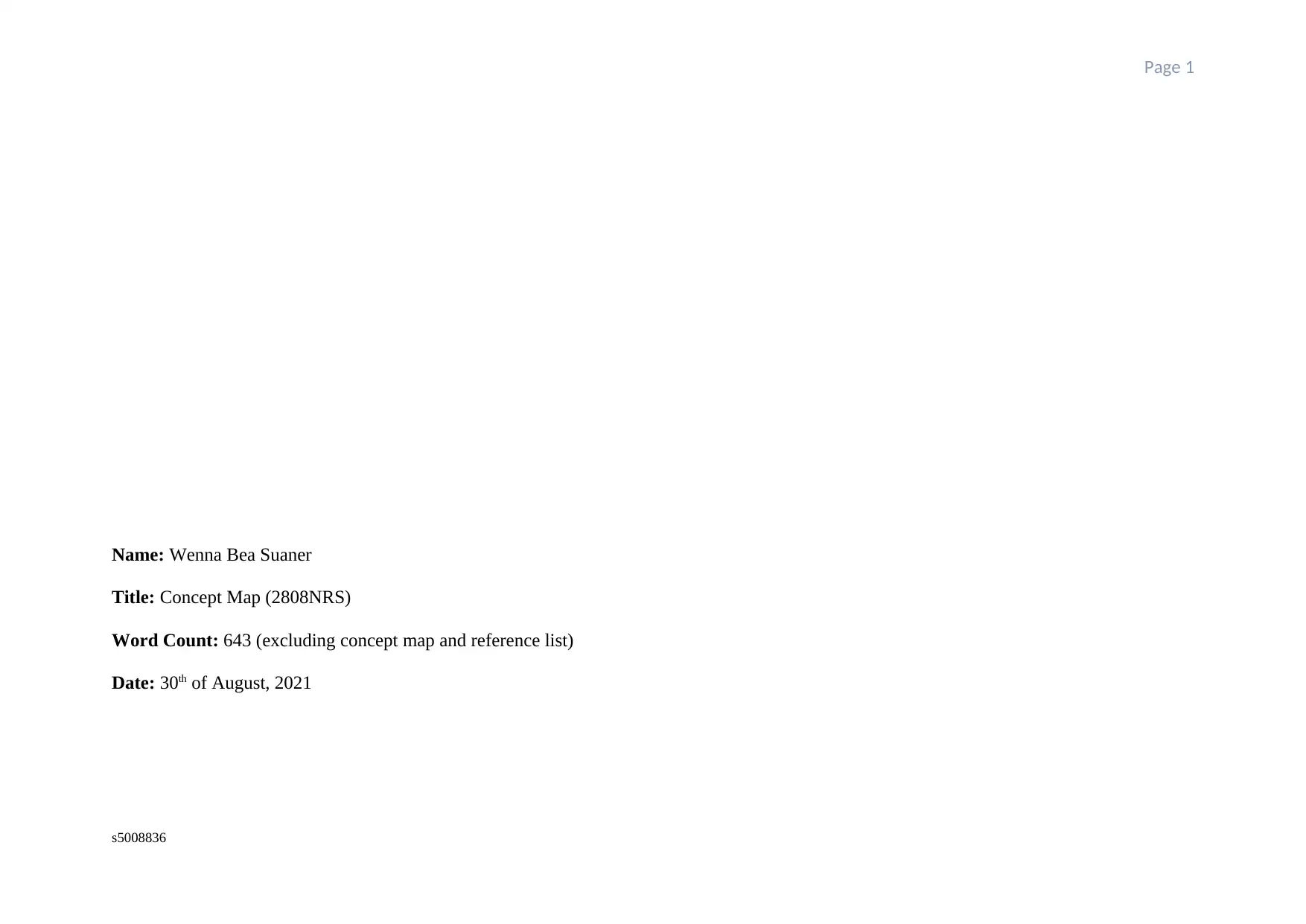
Page 1
Name: Wenna Bea Suaner
Title: Concept Map (2808NRS)
Word Count: 643 (excluding concept map and reference list)
Date: 30th of August, 2021
s5008836
Name: Wenna Bea Suaner
Title: Concept Map (2808NRS)
Word Count: 643 (excluding concept map and reference list)
Date: 30th of August, 2021
s5008836
Paraphrase This Document
Need a fresh take? Get an instant paraphrase of this document with our AI Paraphraser
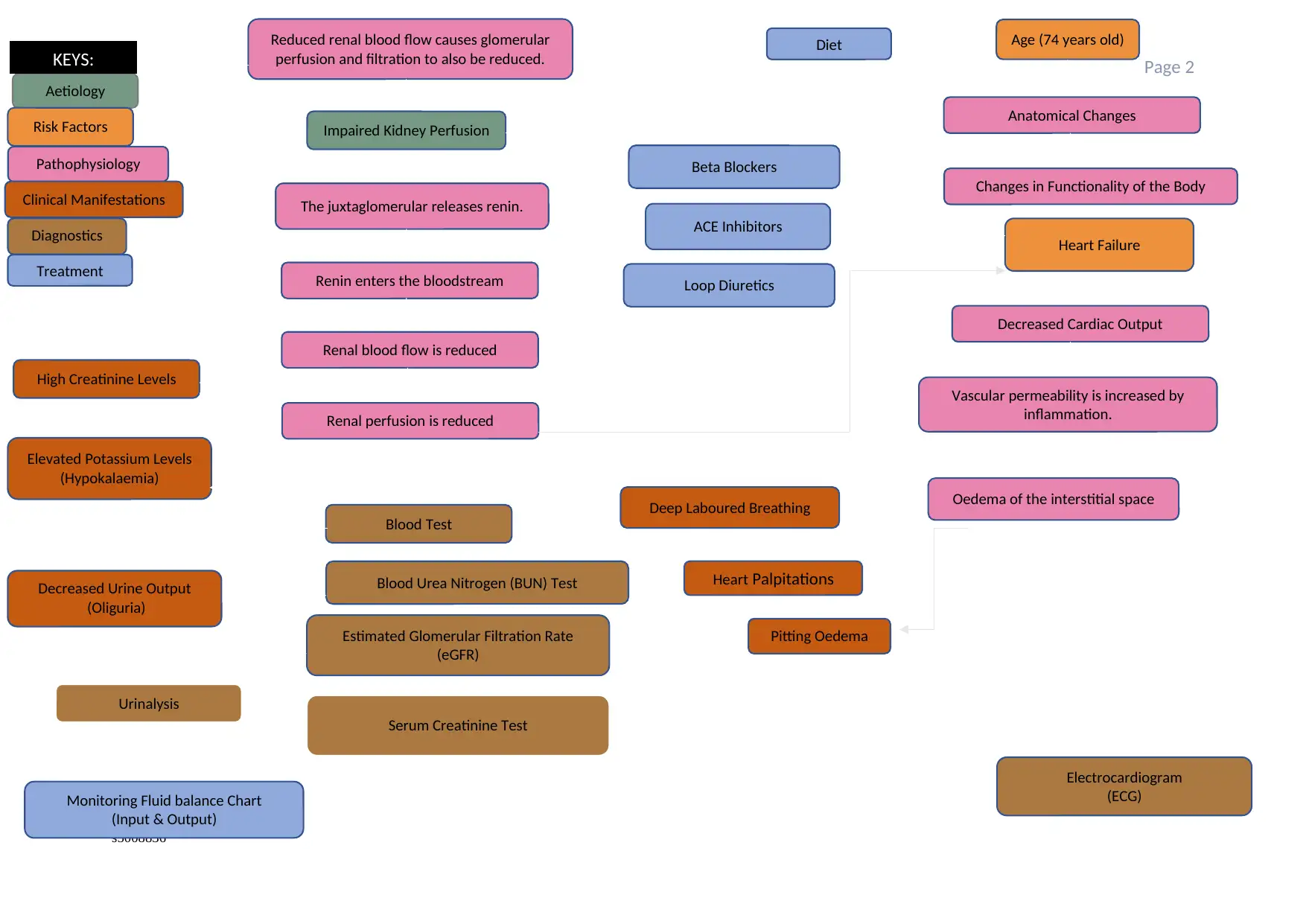
Page 2
s5008836
Aetiology
Risk Factors
Pathophysiology
Clinical Manifestations
Diagnostics
Treatment
Age (74 years old)
Heart Failure
Impaired Kidney Perfusion
Heart Palpitations
Deep Laboured Breathing
Elevated Potassium Levels
(Hypokalaemia)
High Creatinine Levels
Pitting Oedema
Decreased Urine Output
(Oliguria)
Reduced renal blood flow causes glomerular
perfusion and filtration to also be reduced.
The juxtaglomerular releases renin.
Vascular permeability is increased by
inflammation.
Oedema of the interstitial space
Renin enters the bloodstream
Renal blood flow is reduced
Renal perfusion is reduced
Decreased Cardiac Output
Anatomical Changes
Changes in Functionality of the Body
Urinalysis
Blood Test
Estimated Glomerular Filtration Rate
(eGFR)
Blood Urea Nitrogen (BUN) Test
Serum Creatinine Test
Diet
Monitoring Fluid balance Chart
(Input & Output)
Electrocardiogram
(ECG)
Loop Diuretics
ACE Inhibitors
Beta Blockers
KEYS:
s5008836
Aetiology
Risk Factors
Pathophysiology
Clinical Manifestations
Diagnostics
Treatment
Age (74 years old)
Heart Failure
Impaired Kidney Perfusion
Heart Palpitations
Deep Laboured Breathing
Elevated Potassium Levels
(Hypokalaemia)
High Creatinine Levels
Pitting Oedema
Decreased Urine Output
(Oliguria)
Reduced renal blood flow causes glomerular
perfusion and filtration to also be reduced.
The juxtaglomerular releases renin.
Vascular permeability is increased by
inflammation.
Oedema of the interstitial space
Renin enters the bloodstream
Renal blood flow is reduced
Renal perfusion is reduced
Decreased Cardiac Output
Anatomical Changes
Changes in Functionality of the Body
Urinalysis
Blood Test
Estimated Glomerular Filtration Rate
(eGFR)
Blood Urea Nitrogen (BUN) Test
Serum Creatinine Test
Diet
Monitoring Fluid balance Chart
(Input & Output)
Electrocardiogram
(ECG)
Loop Diuretics
ACE Inhibitors
Beta Blockers
KEYS:
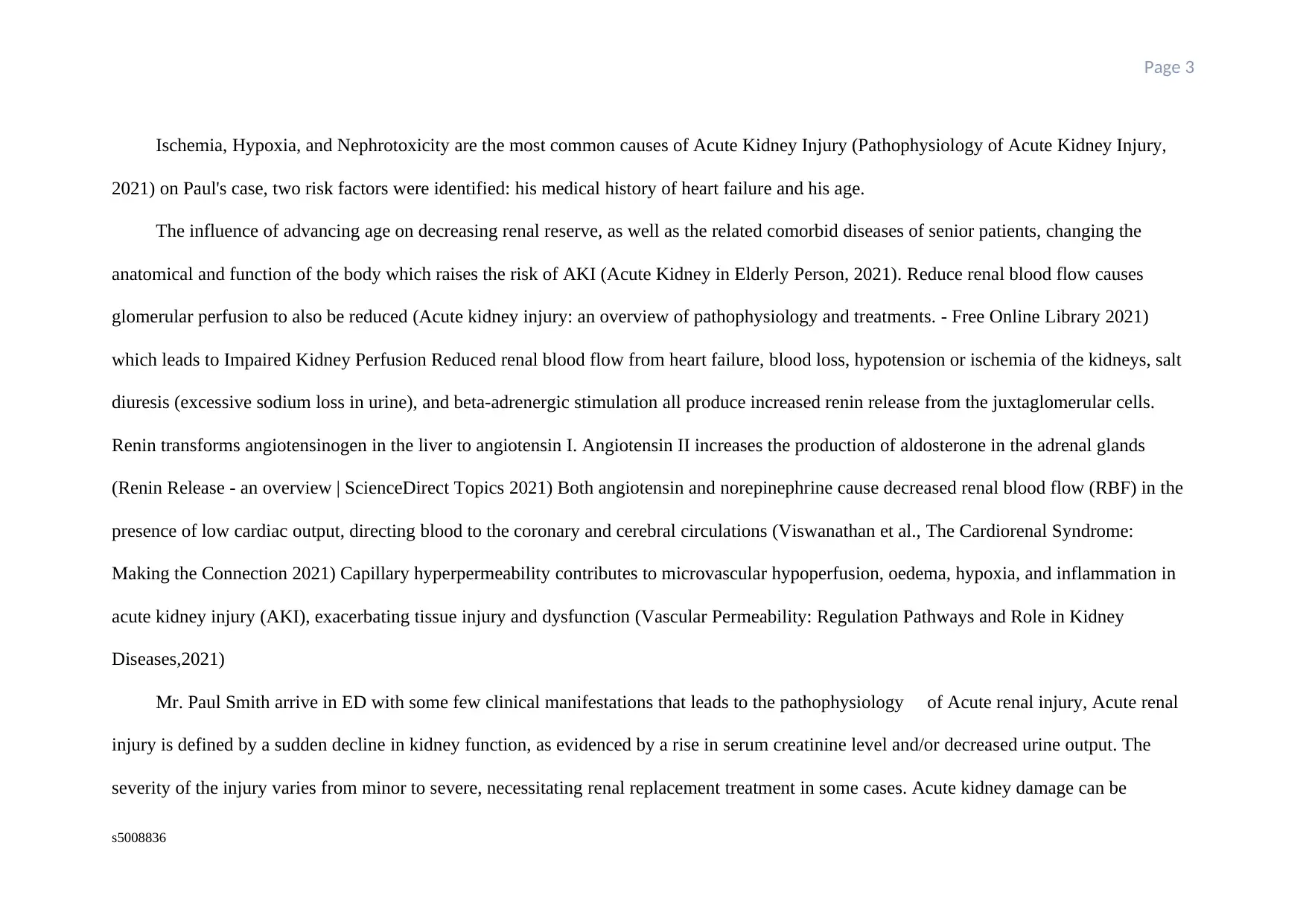
Page 3
Ischemia, Hypoxia, and Nephrotoxicity are the most common causes of Acute Kidney Injury (Pathophysiology of Acute Kidney Injury,
2021) on Paul's case, two risk factors were identified: his medical history of heart failure and his age.
The influence of advancing age on decreasing renal reserve, as well as the related comorbid diseases of senior patients, changing the
anatomical and function of the body which raises the risk of AKI (Acute Kidney in Elderly Person, 2021). Reduce renal blood flow causes
glomerular perfusion to also be reduced (Acute kidney injury: an overview of pathophysiology and treatments. - Free Online Library 2021)
which leads to Impaired Kidney Perfusion Reduced renal blood flow from heart failure, blood loss, hypotension or ischemia of the kidneys, salt
diuresis (excessive sodium loss in urine), and beta-adrenergic stimulation all produce increased renin release from the juxtaglomerular cells.
Renin transforms angiotensinogen in the liver to angiotensin I. Angiotensin II increases the production of aldosterone in the adrenal glands
(Renin Release - an overview | ScienceDirect Topics 2021) Both angiotensin and norepinephrine cause decreased renal blood flow (RBF) in the
presence of low cardiac output, directing blood to the coronary and cerebral circulations (Viswanathan et al., The Cardiorenal Syndrome:
Making the Connection 2021) Capillary hyperpermeability contributes to microvascular hypoperfusion, oedema, hypoxia, and inflammation in
acute kidney injury (AKI), exacerbating tissue injury and dysfunction (Vascular Permeability: Regulation Pathways and Role in Kidney
Diseases,2021)
Mr. Paul Smith arrive in ED with some few clinical manifestations that leads to the pathophysiology of Acute renal injury, Acute renal
injury is defined by a sudden decline in kidney function, as evidenced by a rise in serum creatinine level and/or decreased urine output. The
severity of the injury varies from minor to severe, necessitating renal replacement treatment in some cases. Acute kidney damage can be
s5008836
Ischemia, Hypoxia, and Nephrotoxicity are the most common causes of Acute Kidney Injury (Pathophysiology of Acute Kidney Injury,
2021) on Paul's case, two risk factors were identified: his medical history of heart failure and his age.
The influence of advancing age on decreasing renal reserve, as well as the related comorbid diseases of senior patients, changing the
anatomical and function of the body which raises the risk of AKI (Acute Kidney in Elderly Person, 2021). Reduce renal blood flow causes
glomerular perfusion to also be reduced (Acute kidney injury: an overview of pathophysiology and treatments. - Free Online Library 2021)
which leads to Impaired Kidney Perfusion Reduced renal blood flow from heart failure, blood loss, hypotension or ischemia of the kidneys, salt
diuresis (excessive sodium loss in urine), and beta-adrenergic stimulation all produce increased renin release from the juxtaglomerular cells.
Renin transforms angiotensinogen in the liver to angiotensin I. Angiotensin II increases the production of aldosterone in the adrenal glands
(Renin Release - an overview | ScienceDirect Topics 2021) Both angiotensin and norepinephrine cause decreased renal blood flow (RBF) in the
presence of low cardiac output, directing blood to the coronary and cerebral circulations (Viswanathan et al., The Cardiorenal Syndrome:
Making the Connection 2021) Capillary hyperpermeability contributes to microvascular hypoperfusion, oedema, hypoxia, and inflammation in
acute kidney injury (AKI), exacerbating tissue injury and dysfunction (Vascular Permeability: Regulation Pathways and Role in Kidney
Diseases,2021)
Mr. Paul Smith arrive in ED with some few clinical manifestations that leads to the pathophysiology of Acute renal injury, Acute renal
injury is defined by a sudden decline in kidney function, as evidenced by a rise in serum creatinine level and/or decreased urine output. The
severity of the injury varies from minor to severe, necessitating renal replacement treatment in some cases. Acute kidney damage can be
s5008836
⊘ This is a preview!⊘
Do you want full access?
Subscribe today to unlock all pages.

Trusted by 1+ million students worldwide
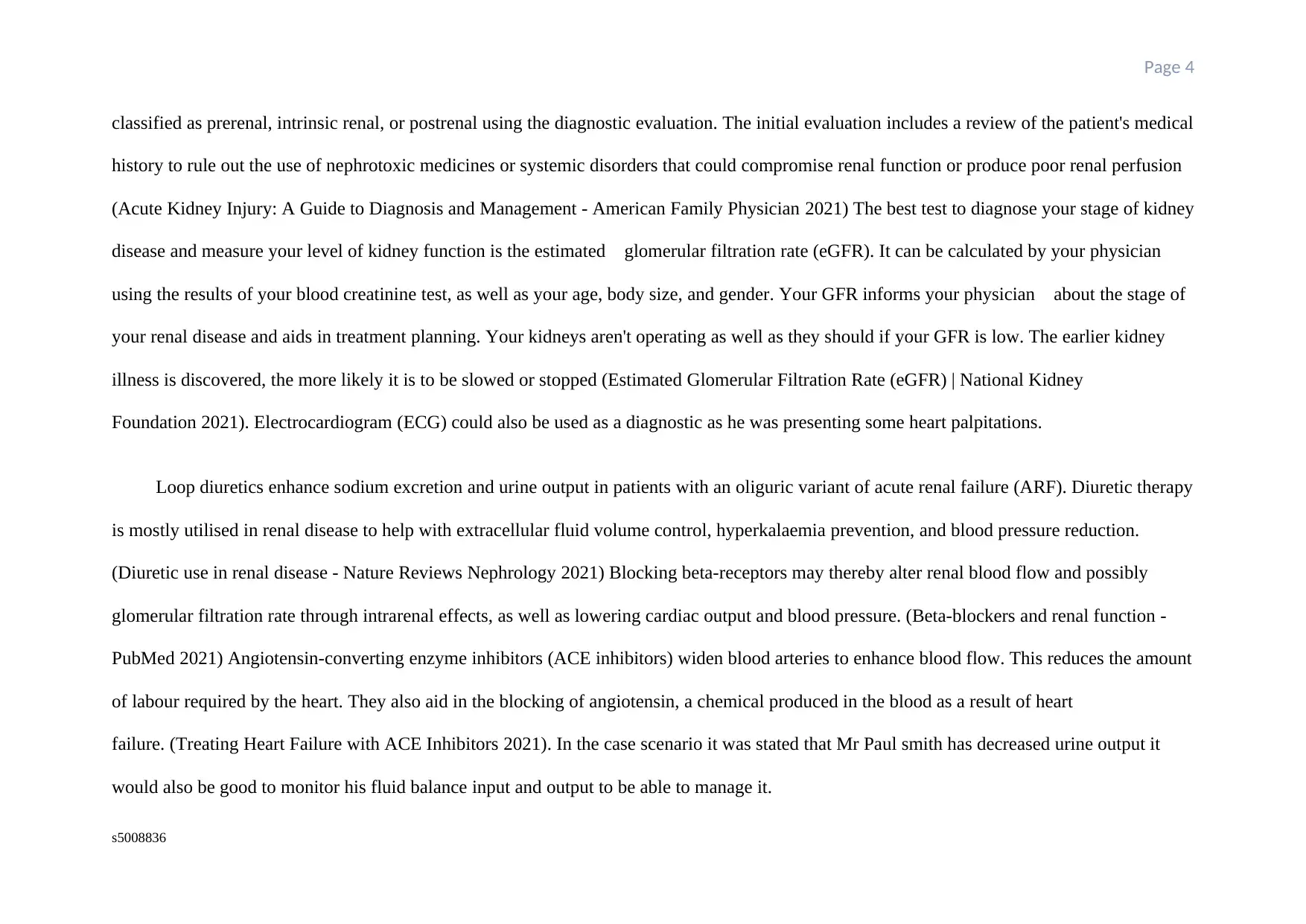
Page 4
classified as prerenal, intrinsic renal, or postrenal using the diagnostic evaluation. The initial evaluation includes a review of the patient's medical
history to rule out the use of nephrotoxic medicines or systemic disorders that could compromise renal function or produce poor renal perfusion
(Acute Kidney Injury: A Guide to Diagnosis and Management - American Family Physician 2021) The best test to diagnose your stage of kidney
disease and measure your level of kidney function is the estimated glomerular filtration rate (eGFR). It can be calculated by your physician
using the results of your blood creatinine test, as well as your age, body size, and gender. Your GFR informs your physician about the stage of
your renal disease and aids in treatment planning. Your kidneys aren't operating as well as they should if your GFR is low. The earlier kidney
illness is discovered, the more likely it is to be slowed or stopped (Estimated Glomerular Filtration Rate (eGFR) | National Kidney
Foundation 2021). Electrocardiogram (ECG) could also be used as a diagnostic as he was presenting some heart palpitations.
Loop diuretics enhance sodium excretion and urine output in patients with an oliguric variant of acute renal failure (ARF). Diuretic therapy
is mostly utilised in renal disease to help with extracellular fluid volume control, hyperkalaemia prevention, and blood pressure reduction.
(Diuretic use in renal disease - Nature Reviews Nephrology 2021) Blocking beta-receptors may thereby alter renal blood flow and possibly
glomerular filtration rate through intrarenal effects, as well as lowering cardiac output and blood pressure. (Beta-blockers and renal function -
PubMed 2021) Angiotensin-converting enzyme inhibitors (ACE inhibitors) widen blood arteries to enhance blood flow. This reduces the amount
of labour required by the heart. They also aid in the blocking of angiotensin, a chemical produced in the blood as a result of heart
failure. (Treating Heart Failure with ACE Inhibitors 2021). In the case scenario it was stated that Mr Paul smith has decreased urine output it
would also be good to monitor his fluid balance input and output to be able to manage it.
s5008836
classified as prerenal, intrinsic renal, or postrenal using the diagnostic evaluation. The initial evaluation includes a review of the patient's medical
history to rule out the use of nephrotoxic medicines or systemic disorders that could compromise renal function or produce poor renal perfusion
(Acute Kidney Injury: A Guide to Diagnosis and Management - American Family Physician 2021) The best test to diagnose your stage of kidney
disease and measure your level of kidney function is the estimated glomerular filtration rate (eGFR). It can be calculated by your physician
using the results of your blood creatinine test, as well as your age, body size, and gender. Your GFR informs your physician about the stage of
your renal disease and aids in treatment planning. Your kidneys aren't operating as well as they should if your GFR is low. The earlier kidney
illness is discovered, the more likely it is to be slowed or stopped (Estimated Glomerular Filtration Rate (eGFR) | National Kidney
Foundation 2021). Electrocardiogram (ECG) could also be used as a diagnostic as he was presenting some heart palpitations.
Loop diuretics enhance sodium excretion and urine output in patients with an oliguric variant of acute renal failure (ARF). Diuretic therapy
is mostly utilised in renal disease to help with extracellular fluid volume control, hyperkalaemia prevention, and blood pressure reduction.
(Diuretic use in renal disease - Nature Reviews Nephrology 2021) Blocking beta-receptors may thereby alter renal blood flow and possibly
glomerular filtration rate through intrarenal effects, as well as lowering cardiac output and blood pressure. (Beta-blockers and renal function -
PubMed 2021) Angiotensin-converting enzyme inhibitors (ACE inhibitors) widen blood arteries to enhance blood flow. This reduces the amount
of labour required by the heart. They also aid in the blocking of angiotensin, a chemical produced in the blood as a result of heart
failure. (Treating Heart Failure with ACE Inhibitors 2021). In the case scenario it was stated that Mr Paul smith has decreased urine output it
would also be good to monitor his fluid balance input and output to be able to manage it.
s5008836
Paraphrase This Document
Need a fresh take? Get an instant paraphrase of this document with our AI Paraphraser
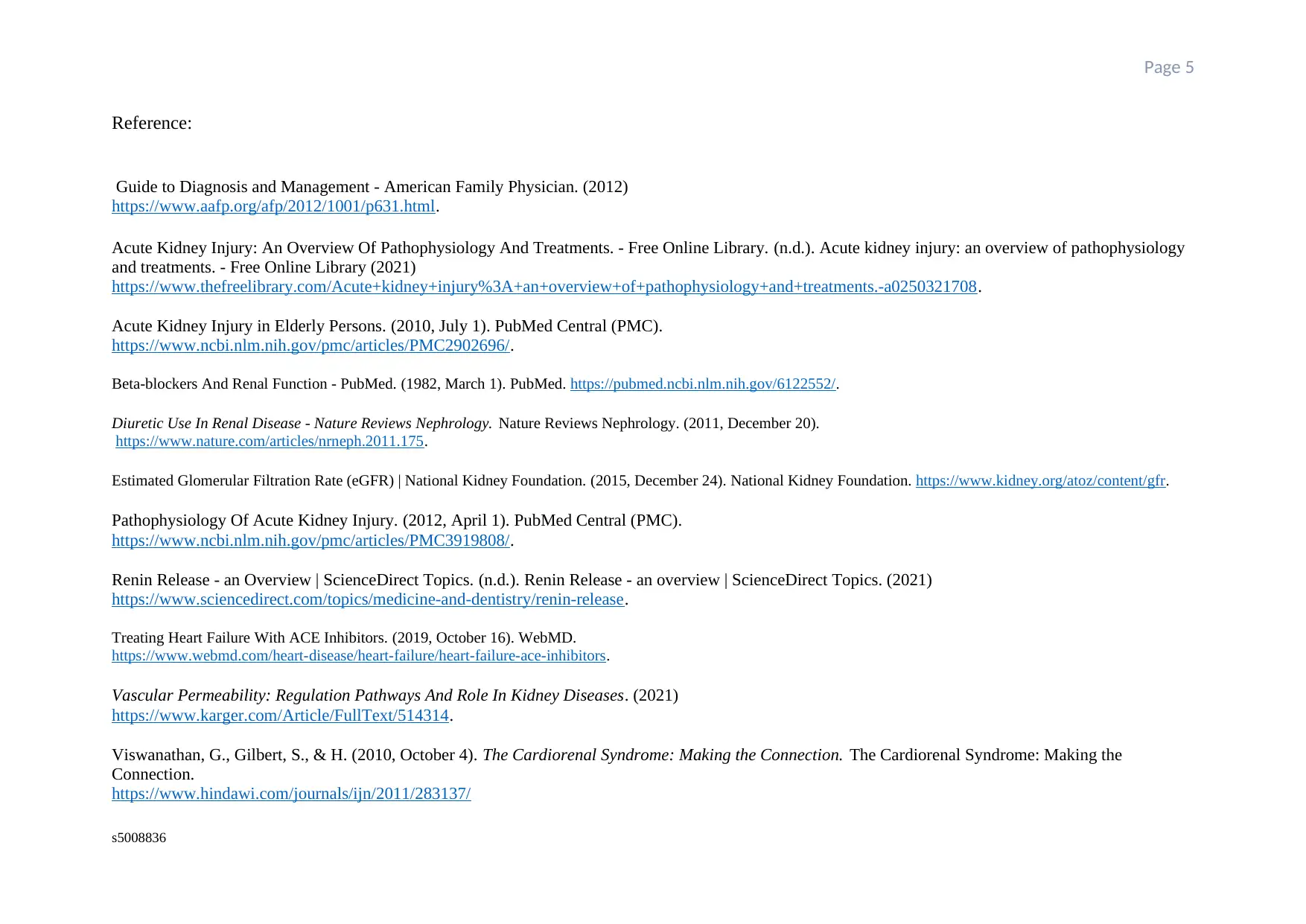
Page 5
Reference:
Guide to Diagnosis and Management - American Family Physician. (2012)
https://www.aafp.org/afp/2012/1001/p631.html.
Acute Kidney Injury: An Overview Of Pathophysiology And Treatments. - Free Online Library. (n.d.). Acute kidney injury: an overview of pathophysiology
and treatments. - Free Online Library (2021)
https://www.thefreelibrary.com/Acute+kidney+injury%3A+an+overview+of+pathophysiology+and+treatments.-a0250321708.
Acute Kidney Injury in Elderly Persons. (2010, July 1). PubMed Central (PMC).
https://www.ncbi.nlm.nih.gov/pmc/articles/PMC2902696/.
Beta-blockers And Renal Function - PubMed. (1982, March 1). PubMed. https://pubmed.ncbi.nlm.nih.gov/6122552/.
Diuretic Use In Renal Disease - Nature Reviews Nephrology. Nature Reviews Nephrology. (2011, December 20).
https://www.nature.com/articles/nrneph.2011.175.
Estimated Glomerular Filtration Rate (eGFR) | National Kidney Foundation. (2015, December 24). National Kidney Foundation. https://www.kidney.org/atoz/content/gfr.
Pathophysiology Of Acute Kidney Injury. (2012, April 1). PubMed Central (PMC).
https://www.ncbi.nlm.nih.gov/pmc/articles/PMC3919808/.
Renin Release - an Overview | ScienceDirect Topics. (n.d.). Renin Release - an overview | ScienceDirect Topics. (2021)
https://www.sciencedirect.com/topics/medicine-and-dentistry/renin-release.
Treating Heart Failure With ACE Inhibitors. (2019, October 16). WebMD.
https://www.webmd.com/heart-disease/heart-failure/heart-failure-ace-inhibitors.
Vascular Permeability: Regulation Pathways And Role In Kidney Diseases. (2021)
https://www.karger.com/Article/FullText/514314.
Viswanathan, G., Gilbert, S., & H. (2010, October 4). The Cardiorenal Syndrome: Making the Connection. The Cardiorenal Syndrome: Making the
Connection.
https://www.hindawi.com/journals/ijn/2011/283137/
s5008836
Reference:
Guide to Diagnosis and Management - American Family Physician. (2012)
https://www.aafp.org/afp/2012/1001/p631.html.
Acute Kidney Injury: An Overview Of Pathophysiology And Treatments. - Free Online Library. (n.d.). Acute kidney injury: an overview of pathophysiology
and treatments. - Free Online Library (2021)
https://www.thefreelibrary.com/Acute+kidney+injury%3A+an+overview+of+pathophysiology+and+treatments.-a0250321708.
Acute Kidney Injury in Elderly Persons. (2010, July 1). PubMed Central (PMC).
https://www.ncbi.nlm.nih.gov/pmc/articles/PMC2902696/.
Beta-blockers And Renal Function - PubMed. (1982, March 1). PubMed. https://pubmed.ncbi.nlm.nih.gov/6122552/.
Diuretic Use In Renal Disease - Nature Reviews Nephrology. Nature Reviews Nephrology. (2011, December 20).
https://www.nature.com/articles/nrneph.2011.175.
Estimated Glomerular Filtration Rate (eGFR) | National Kidney Foundation. (2015, December 24). National Kidney Foundation. https://www.kidney.org/atoz/content/gfr.
Pathophysiology Of Acute Kidney Injury. (2012, April 1). PubMed Central (PMC).
https://www.ncbi.nlm.nih.gov/pmc/articles/PMC3919808/.
Renin Release - an Overview | ScienceDirect Topics. (n.d.). Renin Release - an overview | ScienceDirect Topics. (2021)
https://www.sciencedirect.com/topics/medicine-and-dentistry/renin-release.
Treating Heart Failure With ACE Inhibitors. (2019, October 16). WebMD.
https://www.webmd.com/heart-disease/heart-failure/heart-failure-ace-inhibitors.
Vascular Permeability: Regulation Pathways And Role In Kidney Diseases. (2021)
https://www.karger.com/Article/FullText/514314.
Viswanathan, G., Gilbert, S., & H. (2010, October 4). The Cardiorenal Syndrome: Making the Connection. The Cardiorenal Syndrome: Making the
Connection.
https://www.hindawi.com/journals/ijn/2011/283137/
s5008836

Page 6
s5008836
s5008836
⊘ This is a preview!⊘
Do you want full access?
Subscribe today to unlock all pages.

Trusted by 1+ million students worldwide
1 out of 6
Related Documents
Your All-in-One AI-Powered Toolkit for Academic Success.
+13062052269
info@desklib.com
Available 24*7 on WhatsApp / Email
![[object Object]](/_next/static/media/star-bottom.7253800d.svg)
Unlock your academic potential
Copyright © 2020–2025 A2Z Services. All Rights Reserved. Developed and managed by ZUCOL.





